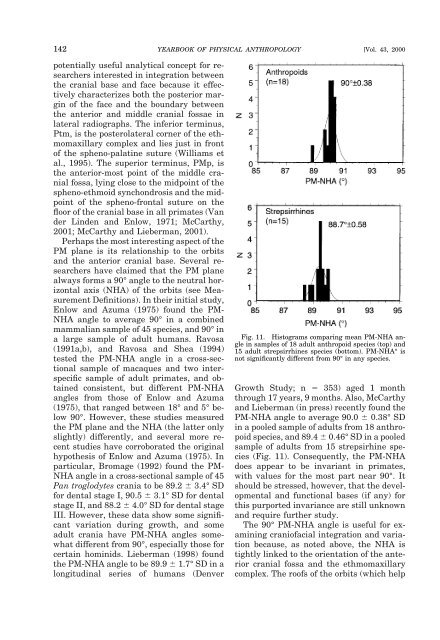The primate cranial base: ontogeny, function and - Harvard University
The primate cranial base: ontogeny, function and - Harvard University
The primate cranial base: ontogeny, function and - Harvard University
Create successful ePaper yourself
Turn your PDF publications into a flip-book with our unique Google optimized e-Paper software.
142 YEARBOOK OF PHYSICAL ANTHROPOLOGY [Vol. 43, 2000<br />
potentially useful analytical concept for researchers<br />
interested in integration between<br />
the <strong>cranial</strong> <strong>base</strong> <strong>and</strong> face because it effectively<br />
characterizes both the posterior margin<br />
of the face <strong>and</strong> the boundary between<br />
the anterior <strong>and</strong> middle <strong>cranial</strong> fossae in<br />
lateral radiographs. <strong>The</strong> inferior terminus,<br />
Ptm, is the posterolateral corner of the ethmomaxillary<br />
complex <strong>and</strong> lies just in front<br />
of the spheno-palatine suture (Williams et<br />
al., 1995). <strong>The</strong> superior terminus, PMp, is<br />
the anterior-most point of the middle <strong>cranial</strong><br />
fossa, lying close to the midpoint of the<br />
spheno-ethmoid synchondrosis <strong>and</strong> the midpoint<br />
of the spheno-frontal suture on the<br />
floor of the <strong>cranial</strong> <strong>base</strong> in all <strong>primate</strong>s (Van<br />
der Linden <strong>and</strong> Enlow, 1971; McCarthy,<br />
2001; McCarthy <strong>and</strong> Lieberman, 2001).<br />
Perhaps the most interesting aspect of the<br />
PM plane is its relationship to the orbits<br />
<strong>and</strong> the anterior <strong>cranial</strong> <strong>base</strong>. Several researchers<br />
have claimed that the PM plane<br />
always forms a 90° angle to the neutral horizontal<br />
axis (NHA) of the orbits (see Measurement<br />
Definitions). In their initial study,<br />
Enlow <strong>and</strong> Azuma (1975) found the PM-<br />
NHA angle to average 90° in a combined<br />
mammalian sample of 45 species, <strong>and</strong> 90° in<br />
a large sample of adult humans. Ravosa<br />
(1991a,b), <strong>and</strong> Ravosa <strong>and</strong> Shea (1994)<br />
tested the PM-NHA angle in a cross-sectional<br />
sample of macaques <strong>and</strong> two interspecific<br />
sample of adult <strong>primate</strong>s, <strong>and</strong> obtained<br />
consistent, but different PM-NHA<br />
angles from those of Enlow <strong>and</strong> Azuma<br />
(1975), that ranged between 18° <strong>and</strong> 5° below<br />
90°. However, these studies measured<br />
the PM plane <strong>and</strong> the NHA (the latter only<br />
slightly) differently, <strong>and</strong> several more recent<br />
studies have corroborated the original<br />
hypothesis of Enlow <strong>and</strong> Azuma (1975). In<br />
particular, Bromage (1992) found the PM-<br />
NHA angle in a cross-sectional sample of 45<br />
Pan troglodytes crania to be 89.2 3.4° SD<br />
for dental stage I, 90.5 3.1° SD for dental<br />
stage II, <strong>and</strong> 88.2 4.0° SD for dental stage<br />
III. However, these data show some significant<br />
variation during growth, <strong>and</strong> some<br />
adult crania have PM-NHA angles somewhat<br />
different from 90°, especially those for<br />
certain hominids. Lieberman (1998) found<br />
the PM-NHA angle to be 89.9 1.7° SD in a<br />
longitudinal series of humans (Denver<br />
Fig. 11. Histograms comparing mean PM-NHA angle<br />
in samples of 18 adult anthropoid species (top) <strong>and</strong><br />
15 adult strepsirrhines species (bottom). PM-NHA° is<br />
not significantly different from 90° in any species.<br />
Growth Study; n 353) aged 1 month<br />
through 17 years, 9 months. Also, McCarthy<br />
<strong>and</strong> Lieberman (in press) recently found the<br />
PM-NHA angle to average 90.0 0.38° SD<br />
in a pooled sample of adults from 18 anthropoid<br />
species, <strong>and</strong> 89.4 0.46° SD in a pooled<br />
sample of adults from 15 strepsirhine species<br />
(Fig. 11). Consequently, the PM-NHA<br />
does appear to be invariant in <strong>primate</strong>s,<br />
with values for the most part near 90°. It<br />
should be stressed, however, that the developmental<br />
<strong>and</strong> <strong>function</strong>al <strong>base</strong>s (if any) for<br />
this purported invariance are still unknown<br />
<strong>and</strong> require further study.<br />
<strong>The</strong> 90° PM-NHA angle is useful for examining<br />
craniofacial integration <strong>and</strong> variation<br />
because, as noted above, the NHA is<br />
tightly linked to the orientation of the anterior<br />
<strong>cranial</strong> fossa <strong>and</strong> the ethmomaxillary<br />
complex. <strong>The</strong> roofs of the orbits (which help
















